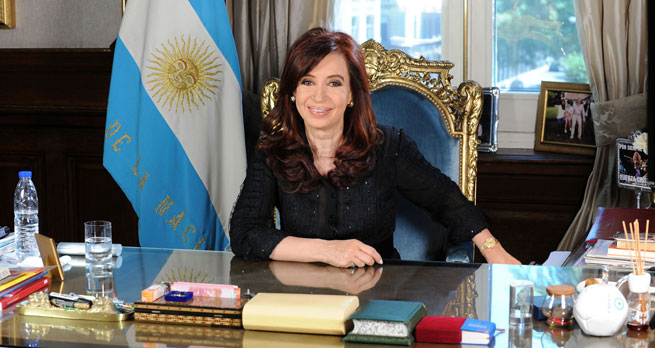With the race to succeed Cristina Fernandez de Kirchner at a fever pitch, Argentina is suddenly facing its first ever presidential runoff.
Against all predictions, the provisional results from the first round show the ruling Victory Front (VF) candidate Daniel Scioli with a tight lead of 36.78%, followed by the Cambiemos (Let’s Change) coalition with 34.40%. Former Kirchner ally Sergio Massa of A New Alternative (UNA) was eliminated with just over 21%.
 Outgoing president Cristina Fernandez de Kirchner
Outgoing president Cristina Fernandez de Kirchner
This is a pretty remarkable result. Turnout was high by Argentine standards, at over 80%, and all the opinion polls were radically wide of the mark. Although a second round was thought to be likely, no one anticipated this tight a race.
Kirchner’s VF remains the most important force in parliament, improving its existing majority of the senate and remaining the largest faction in the lower chamber. But it suffered a humiliating loss in Buenos Aires province, where Eugenia Vidal of Let’s Change became the first non-Peronist governor to win there since the first post-authoritarian election in 1983. More embarrassingly still, her predecessor was Scioli himself.
These failures prove that although Kichnerism has become a powerful political identity, its standard-bearers can still lose elections if they end up fighting among themselves.
Uneasy bedfellows
Daniel Scioli was not an obvious choice of candidate. Given he’s always stuck to his own opinions and was a protégé of disgraced neoliberal president Carlos Menem, “Kirchnerista” hardliners have always regarded him with deep suspicion. Nonetheless, he has stayed loyal to Nestor and Cristina, serving in high office first as Nestor’s vice-president and then as governor of Buenos Aires during Cristina’s two terms.
By endorsing Scioli, Cristina has managed to keep her governing coalition from splitting completely into “Sciolista” and Kirchnerista camps, but she was unable to prevent the defection of Sergio Massa, who at just 36 years old served as Cristina’s former Chief of the Cabinet of Ministers. UNA’s first round votes are now up for grabs, and could well decide the overall outcome in round two.
So is this result the fault of an underperforming Scioli, or the work of a surging opposition? The short answer is a bit of both.
Mauricio Macri, the son of an Italian migrant and prominent businessman, constructed a successful new political party (PRO) which developed solid bases in Buenos Aires city, winning consecutive elections since 2007. Together with the traditional UCR and other smaller parties, his alliance Let’s Change (Cambiemos) achieved an extraordinary election result by moving away from their original radically pro-market platforms – a wise move indeed.
Running out of steam
Many of the Kirchner era’s banner initiatives have worked hard to meet the unfulfilled social demands of the neoliberal 1990s, and by doing so, the Kirchners have forged a strong political identity of combative resistence against neoliberalism in all its forms.
But the antagonism that founded Argentina and Latin America’s “post-neoliberal consensus” has been all but exhausted. Voters are making new demands of their leaders, and in its current form, Kirchnerism has proved unable to address them fully. That much is apparent in Scioli’s inability to close the deal. He has failed to speak to the demands of the urban middle class, indigenous people, and communities affected by major mining projects, who are clamouring for better living standards and new curbs on the excesses of extractive industries.
In addition, slow growth in China and recession in Brazil mean that the prospect of quick recovery of commodity prices and foreign investment looks uncertain. This means that the Argentine economy will struggle to return to fast rates experienced over the past decade or so.
For his part, Macri seems to have a rather better grasp of the new landscape, in particular the interests of the new middle class – whose living standards, paradoxically enough, have actually recovered and improved under the Kirchners' employment-focused macroeconomic policies.
The first round vote was conducted in an atmosphere of general sense of normality, with Argentina’s Pumas playing in the Rugby World Cup semi-finals on the same day. But the tight result at last stirred things up. Everyone is now on notice: Argentina’s hard-won post-neoliberal consensus might, against all predictions, actually be at stake.![]()
This article was originally published on The Conversation. Read the original article.
Rate and Review
Rate this article
Review this article
Log into OpenLearn to leave reviews and join in the conversation.
Article reviews